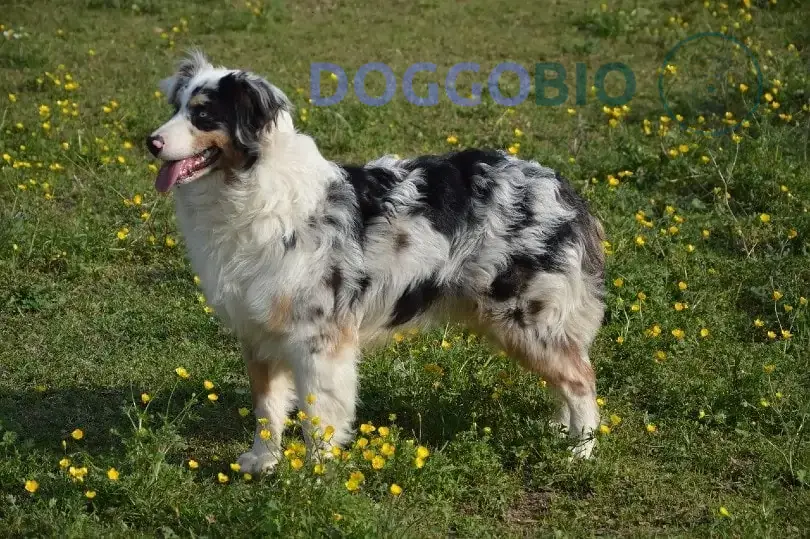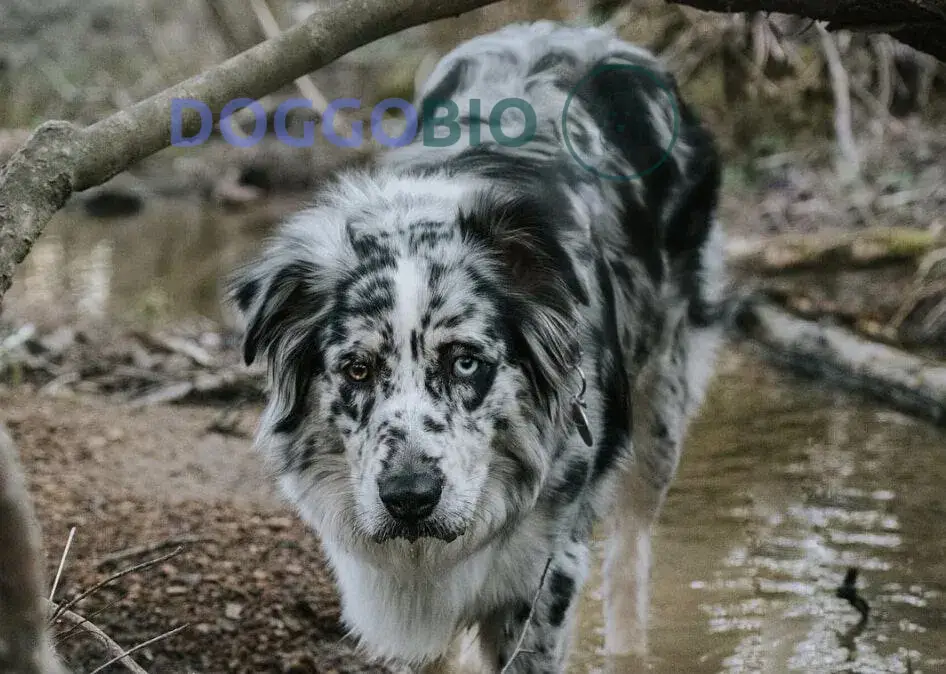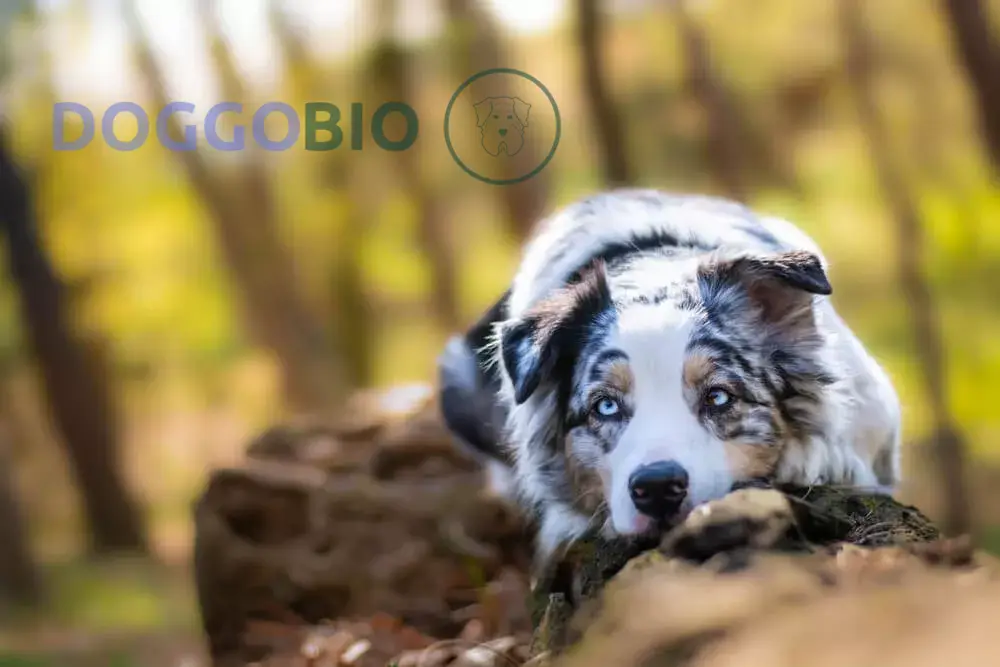The Blue Merle Australian Shepherd is a captivating and striking breed that captures the hearts of dog enthusiasts worldwide. With its unique coat pattern and intelligent demeanor, this breed stands out.
Originally bred as working dogs, Blue Merle Australian Shepherds possess an impressive combination of agility, versatility, and loyalty, making them ideal companions for active families and experienced handlers.
This introduction will delve into the fascinating characteristics, history, and care requirements of the Blue Merle Australian Shepherd, shedding light on why this breed has gained such popularity among dog lovers everywhere.
Whether you’re considering adding one to your family or are intrigued by their beauty and abilities, prepare to embark on a captivating journey into the world of the Blue Merle Australian Shepherd.
A Brief Overview of Blue Merle Australian Shepherd
| Attribute | Blue Merle Australian Shepherd |
| Other Names | Blue Merle Aussie Shepherd, Blue Merle Aussie |
| Purity | Purebred |
| Purpose | Herding, Companion |
| AKC Recognition | Yes |
| Size | Medium |
| Height | 18-23 inches |
| Weight | 40-65 pounds |
| Colors | Dark blue, light blue, harlequin blue, chocolate blue, bicolor, tricolor |
| Child Friendliness | High |
| Canine Friendliness | Moderate |
| Training Difficulty | Low |
| Grooming Upkeep | Moderate |
| Exercise Needs | High |
| Health | Moderate |
| Lifespan | 12-15 years |
| Puppy Cost | $1,000-$2,500 |
What is A Blue Merle Australian Shepherd?

A Blue Merle Australian Shepherd is not a distinct breed on its own, but rather an Australian Shepherd with a Blue Merle coat color pattern. The name accurately describes their striking appearance, with a coat displaying the Blue Merle pattern.
It’s important to note that Blue Merle Australian Shepherds are still considered Australian Shepherds, and the term primarily refers to their unique coat coloring rather than being a separate breed.
What makes a dog blue merle?
According to the ASCA (Australian Shepherd Club of America), the merle gene is crucial in determining whether a dog is a merle, whether it is a red or blue merle. This gene is referred to as an “incomplete dominant.”
Possessing only one copy of this gene is sufficient for the blue merles we see. However, when two dominant copies are present, a “double merle” condition arises. Dogs with this genetic makeup often experience severe health issues, ranging from eye defects to deafness.
Conversely, two recessive gene copies will produce a non-merle Australian Shepherd. The ideal scenario has one dominant and one recessive copy, resulting in a merle Aussie.
What Does a Blue Merle Australian Shepherd Look Like?

Size, height, and Weight
When fully grown, an Australian Shepherd typically reaches a height of about 18 to 23 inches and weighs between 40 and 65 pounds.
It’s worth noting that male dogs tend to be taller and heavier than females. Additionally, the timing of neutering can impact the dog’s adult size.
| Male | Female | |
| Size Group | Medium | Medium |
| Height | 20-23 inches | 18-21 inches |
| Weight | 50-65 pounds | 40-55 pounds |
Coat Colors and Types
Blue Merle Australian Shepherds’ coat is a mesmerizing blend of colors, typically including shades of grey, white, black, and tan or red. The specific pattern varies uniquely from one dog to another, but it is common to see a white bib and muzzle accompanied by colored patches around one or both eyes.
The eye color of a blue merle can range from blue to amber or brown, and it is not uncommon for them to exhibit heterochromia, where each eye has a different color.
Types of Blue Merle Australian hepherd
Blue Merle Australian Shepherds showcase a spectrum of eye-catching coat patterns, proving that ‘blue Merle’ is more than just one color – it’s the foundational hue for the breed.
There are four unique and mesmerizing variations within this category, each with its own rarity and distinctive beauty.
1. Solid Blue Merle Australian Shepherd

Surprisingly, Solid Blue Merles are less widespread than one might assume. Their coats boast a base color of gray adorned with distinctive black spots or patches, which can vary in shape and size across their entire body.
2. Blue Merle Tri Australian Shepherd

Like other blue merles, these Australian Shepherds possess a base coat of blue merle, characterized by black patches on a backdrop of gray and white. However, the addition of exquisite highlights sets the blue Merle tri apart. These highlights manifest as accents of white and copper or tan, adorning the muzzle, ears, legs, bottom, and chest.
3. Blue Merle & White Australian Shepherd

These dogs possess the iconic blue merle coat as their base color. However, unlike the tri-color variation, they lack their coat’s copper and tan markings. Instead, their distinguishing feature lies in the presence of white markings. Hence, they are referred to as “blue merle and white.”
Due to the absence of tan markings, they may resemble Siberian Huskies, especially during their puppyhood months. This resemblance often leads to them being mistaken for huskies.
4. Blue Merle & Tan Australian Shepherd

These dogs feature the splendid blue merle coat, characterized by black patches on a backdrop of gray fur, with the addition of tan and copper markings.
To the untrained eye, distinguishing between the “blue merle & tan” and “blue merle tri color” can be challenging. The color distinction between the white markings and the gray fur of the blue merle may not always be readily apparent.
Although sightings of Blue Merle & Tan Australian Shepherds occur occasionally, specifically seeking out this color variation may prove challenging.
Temperament and Personality

The Blue Merle Australian Shepherd is a brilliant and active breed, making them an excellent choice for those seeking an energetic and intelligent companion. They are devoted and protective of their families, although they may be reserved with strangers. Early socialization is essential to help them become well-rounded dogs.
The Blue Merle Australian Shepherd is loyal, loving, and protective as a family pet. However, they must know their herding instincts, as they may try to herd children and other pets. Training should focus on preventing nipping or biting behaviors. While they can be problematic with smaller pets due to their chasing tendencies, they generally get along well with other dogs.
Training and Exercise Requirements
Training the Blue Merle Australian Shepherd is a rewarding experience due to their intelligence and willingness to work. Starting early with training and socialization sets the foundation for a well-behaved companion.

Being an active breed, the Blue Merle Aussie requires ample exercise to stay physically and mentally stimulated. Daily walks or runs are essential, but engaging in activities like agility or flyball training can provide even more enrichment. Without sufficient exercise, they may resort to destructive behaviors.
Grooming and Cleaning
Fortunately, Australian Shepherds are not heavy shedders, except during shedding seasons. However, regular brushing is still necessary to maintain their coat.
It is recommended to brush your Australian Shepherd at least once a week. An undercoat brush can remove dead hair during shedding periods, preventing mats and potential skin infections.
| Grooming Task | Frequency |
| Hair Brushing | 1-2 times a week |
| Bathing | Every 6 weeks |
| Ear Cleaning | Weekly |
| Tooth Cleaning | 2-3 times a week |
| Haircutting | As needed |
| Nail Trimming | Weekly |
Food and Diet

Feeding Australian Shepherds requires high-quality dog food to match their active lifestyle. Opt for food that provides excellent protein and carbohydrate sources, ideally formulated for working breeds. Remember, each dog is unique, so balancing their diet with exercise is key to avoiding weight gain.
Proper portion control is crucial, as any dog can gain weight if overfed. If you’re unsure about the right amount to feed your Aussie, it’s best to seek advice from a veterinarian or a veterinary technician, who can offer guidance specific to your dog’s individual needs.
Life Expectancy and Common Health Issues
When you embrace a blue merle Australian Shepherd as a family member, you can anticipate a lifespan of approximately 12 to 16 years.
It’s important to know that Blue Merle Australian Shepherds may have a higher likelihood of specific health issues. While Australian Shepherds are generally known for their overall good health, blue merles are more prone to particular conditions. Such as:

- Congenital deafness
- Hip dysplasia,
- Elbow dysplasia,
- Cataracts,
- Epilepsy,
- Progressive Retinal Atrophy,
- An eye condition.
Fortunately, many responsible breeders prioritize the health of their dogs and conduct thorough health tests before breeding. This proactive approach helps ensure that potential health conditions are identified and minimized in the offspring of blue merle Australian Shepherds.
How Much Is a Blue Merle Australian Shepherd?
Blue Merle Australian Shepherds are priced higher due to their unique and sought-after appearance. While not the rarest, their exotic look drives demand, leading to premium pricing.
The cost has risen with their popularity; reputable breeders may charge from $800 for tri-colors to $1000 for Blue Merles, a notable increase from the average $650 for an Australian Shepherd.
Is a Blue Merle Australian Shepherd the Right Dog for You?
The Blue Merle Australian Shepherd could be the perfect fit if you have an energetic and active family.
However, if you have limited space or cannot meet the exercise requirements of this high-energy breed, there may be better choices for you.
List of dogs that are similar to Blue Merle Australian Shepherd
- Australian Shepherd-Blue Heeler Mix
- Australian Shepherd-Catahoula Mix
- Australian Shepherd-Rottweiler Mix
- Blue Merle Aussiedoodle
Frequently Asked Questions
Does AKC recognize Blue Merle Australian Shepherd?
Yes, the Blue Merle Australian Shepherd is officially recognized by the American Kennel Club (AKC) as a variation of the Australian Shepherd breed.
Blue Merle is considered a distinct coat color within the AKC, but there is no specific breed standard for Blue Merle Aussies. Instead, they are evaluated and judged based on the general breed standard for Australian Shepherds.
Are Australian Shepherds hypoallergenic?
Unfortunately, the Blue Merle Australian Shepherd is not hypoallergenic. They are moderate shedders, which can challenge individuals with dog allergies.
Do Australian Shepherds Shed a lot?
Yes, Australian Shepherds shed quite a bit due to their thick double coat. They are considered moderate to heavy shedders, with daily hair shedding being common. During certain times, they “blow their coat,” shedding even more noticeably.
Are Australian Shepherds Good With Kids?
Yes, Australian Shepherds are generally great with kids. Their sturdy build, easy training, and high energy levels make them suitable playmates for children.
Are blue merle Australian Shepherds Rare?
No, they are not considered rare. The blue merle color pattern is quite common within this breed, even more so than the red merle.
However, while their color may not be exclusive, each blue merle Australian Shepherd possesses unique markings and a distinctive personality that sets them apart in their unique way.
How Many Teeth Does a German Shepherd Have?
German Shepherd puppies start with 14 teeth on each jaw at 1.5 months, including incisors, canines, and premolars. By six months, they typically have 28 milk teeth before transitioning to 42 adult teeth, with occasional minor variations due to protective training or vigorous play. Taking care of German Shepherd teeth from the outset helps ensure their dental health as they grow.
Conclusion
In conclusion, the Blue Merle Australian Shepherd is a remarkable breed that embodies beauty, intelligence, and loyalty. From its stunning coat pattern to impressive working abilities, this breed continues to capture the admiration of dog enthusiasts worldwide.
Whether as a loving family pet, a dedicated working companion, or an active participant in dog sports, the Blue Merle Australian Shepherd excels in various roles with its agile nature and unwavering devotion.
However, it is essential to note that this breed requires consistent training, mental stimulation, and regular exercise to thrive and maintain its well-being. The Blue Merle Australian Shepherd may be the perfect match if you’re ready to embark on a rewarding journey with a captivating canine companion.
With their unique blend of beauty, intelligence, and loyalty, these dogs have undoubtedly left an indelible mark on the hearts and lives of many, and they continue to bring joy and fulfillment to those fortunate enough to call them family.

Pingback: Australian Shepherd Rottweiler Mix: Strength Meets Loyalty 2024
Pingback: Catahoula Australian Shepherd Mix: Adorable & Energetic 2024
Pingback: Do Australian Shepherds Shed? Unlock Shed-Free Bliss! 2024
Pingback: German Shepherd Teeth Care: Canine Dental Guide 2024
Pingback: Are Australian Shepherds Good With Kids? A Special Bond 2024